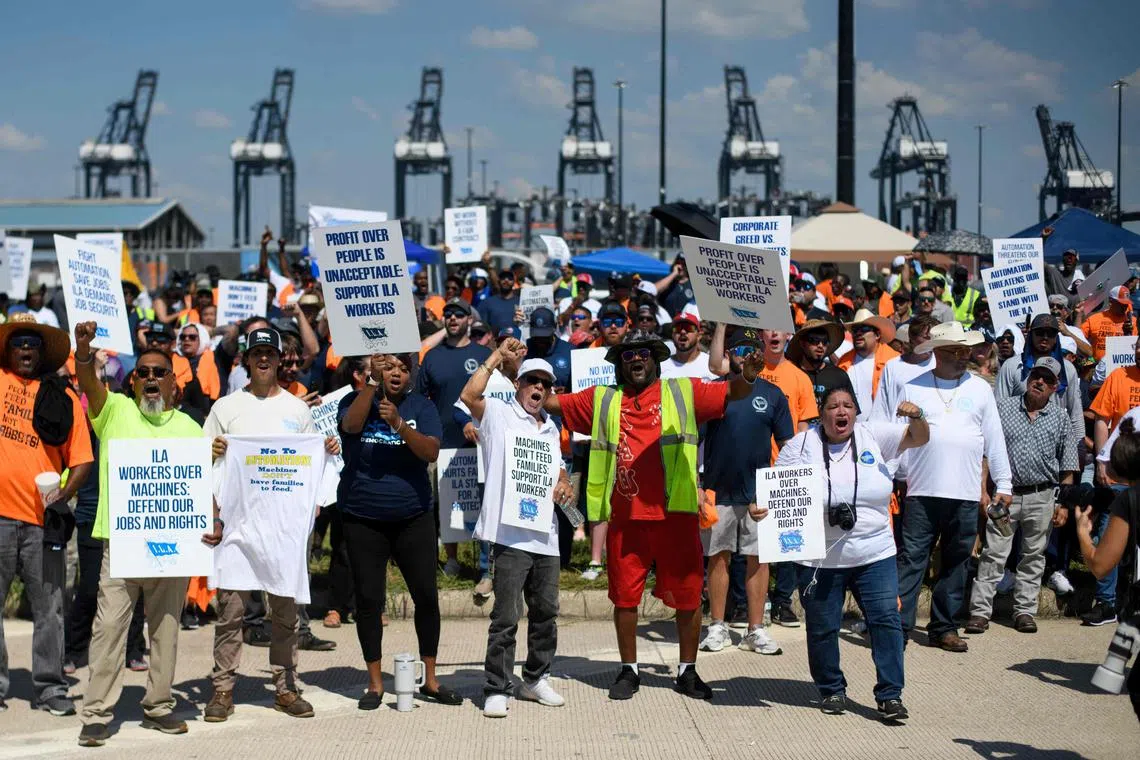US port strike could result in global supply chain disruptions, add to economic uncertainty
Sign up now: Get ST's newsletters delivered to your inbox

After a three-day strike in October 2024 that won generous pay concessions, the union agreed to suspend its walkout until mid-January.
PHOTO: AFP
Follow topic:
Los Angeles – Around 47,000 cargo handlers at every major Eastern US and Gulf Coast port are threatening to walk off the job on Jan 16 if negotiations between longshore workers and their employers on whether automation is used at the ports remain at an impasse.
Negotiations between the International Longshoremen’s Association (ILA) and the US Maritime Alliance (USMX) are set to resume on Jan 7.
Should the ILA and USMX fail to finalise a new master agreement before an existing contract extension expires on Jan 15, the union intends to strike across US East and Gulf Coast ports beginning on Jan 16.
In early October, a three-day ILA strike won generous pay concessions for dock workers,
The ILA wants stronger protections for workers, specifically closing loopholes that allow some of their duties to be done by semi-autonomous equipment.
A strike over the short term can be a good thing for the carriers because it allows them to charge more. In the longer run, though, it leads to unreliable schedules and unhappy customers.
At least five shipping lines have alerted customers to expect surcharges for containers affected by a strike.
However, if a strike drags on for weeks, shipping lines could cancel voyages so that their vessels are not waiting outside harbours indefinitely. Their system is designed without much flexibility: A ship that is delayed entering a port by a week will be a week late on its return trip.
The end result is tighter capacity, which has been an ongoing issue because of Houthi attacks in the Red Sea that forced ships to take the longer route around southern Africa instead of passing through the Suez Canal.
This would lead to bottlenecks across the global maritime supply chain and higher prices for shippers and consumers. Companies can expect to see delays in cargo and higher freight rates, some of which could be passed on to consumers through increased prices.
Singapore would be among those most likely to be affected, given the Republic’s role as a regional transshipment hub and its high dependence on trade.
Most economists expect another strike will be a non-event if it lasts less than a week or two. Delayed shipments will arrive before long, and the hit to gross domestic product will be negligible.
The forecasts for damage range from US$1 billion (S$1.37 billion) to US$5 billion in lost activity each day – a small fraction of the US$29 trillion US economy.
The problems start to compound, however, if it lasts more than a few weeks, with component and product shortages weighing on industrial production and consumer sentiment. BLOOMBERG
Additional reporting by Kang Wan Chern

